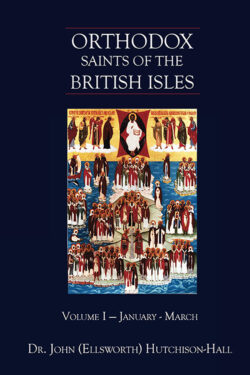
Orthodox Saints of the Pre-Schism
See of Rome
6th March (NS) — 22nd February (OS) 2024
ELWIN, (Sixth Century), though no reliable Life is extant, it seems that St. Elwin accompanied St. Breaca (4th June) and six others from Ireland to Cornwall in the sixth century. A chapel in Sithney parish, Cornwall, has been dedicated to St. Elwen since the 13th century, and in Brittany, several sites and place names are associated with possibly related figures.
JOHN the SAXON, a native of Friesland who was invited to England by St. Alfred the Great (26th October), King of Wessex (r. 871–886) and King of the Anglo-Saxons (r. 886–899), along with other holy and learned men, to restore monasticism in England following the Danish invasions. St. John was made Abbot of Athelney in Somersetshire, where his zeal for the restoration of Religious discipline led to his being murdered in 895 whilst kneeling in prayer in his oratory.

Mosaic of Emperor Justinian and his retinue in the Basilica of San Vitale. Ravena, Italy
(St. Maximian is third from the right)
MAXIMIAN of RAVENNA, consecrated the twenty-seventh Bishop of Ravenna (northern Italy) by Pope Vigilius in 546, St. Maximian was active in the building and furnishing of churches throughout his See, most notably the completion of the Basilica of St. Vitale, and the Throne of Maximian a cathedra carved entirely from ivory, now housed at the Museo Arcivescovile in Ravenna. The Diocese of Ravenna was elevated to an Archdiocese during St. Maximian’s episcopate, making him the first Archbishop as well. St. Maximian reposed circa 556.
PASCHASIUS, an early fourth century Bishop of Vienne (south-eastern France). St. Paschasius reposed in 312, nothing more is known of his life.
RAYNERIUS (RAYNIER), a monk at Beaulieu Abbey near Limoges (south-west-central France). St. Raynerius reposed circa 967.
Get your copy of Orthodox Saints of the British Isles today.
Available at Amazon or your favourite e-bookstore.
BALDRED (BALTHER), a Scottish bishop thought by many to have been the successor of St. Kentigern Mungo (13th January) at Glasgow, St. Baldred ended his life as an anchorite at Bass Rock on the coast of the Firth of Forth. He reposed circa 756 and his relics were enshrined in Durham with those of St. Bilfrid (vide infra).
BASIL, an early fourth century Bishop of Bologna. Consecrated by Pope St. Sylvester (31st December), St. Basil ruled the See for twenty years.
BILFRID (BILLFRITH), a hermit at Lindisfarne, St. Bilfrid was an expert goldsmith and bound in gold the Lindisfarne Gospels, written, and illuminated by St. Eadfrith (4th June). His repose took place between 740 and 756, though the day is uncertain; 6th March is the anniversary of the translation of his relics, along with those of St. Balther (vide supra), to Durham.
CADROE (CADROEL), the son of a Scottish prince, St. Cadroe studied at Armagh in Ireland. He then went to France, where he received monastic tonsure at the Abbey of St. Benedict on the Loire (abbaye de Saint-Benoît-sur-Loire — Fleury Abbey). Soon he was made Abbot of the new Abbey of Waulsort on the River Meuse, present-day Namur Belgium. Finally, St. Cadroe was made Abbot of the Abbey of Saint Clément, in Metz. St. Cadroe reposed in 976.
CHRODEGANG, mayor of the palace of Austrasia Charles Martel's (†741) prime minister, St. Chrodegang was a layman when he was made Bishop of Metz in 732. Maintaining the premiership whilst also Bishop, Chrodegang founded Abbey of St. Gorgonius of Gorze (abbaye Saint-Gorgon de Gorze) in 749, and St. Peter's Abbey on the Moselle, as well as providing significant assistance to Gengenbach (Kloster Gengenbach) and Lorsch (Reichsabtei Lorsch) Abbeys. St. Chrodegang reposed in 766.
CYNEBURH, CYNESWITH, and TIBBA, SS. Cyneburh and Cyneswith were daughters of Penda of Mercia in England, who was notorious for his opposition to Christianity. On the death of her husband, Alchfrith of Northumberland (†c. 665), St. Cyneburh founded a monastery in Castor in Northamptonshire. She was joined by her sister St. Cyneswith, who succeeded her as abbess, and their relative St. Tibba. Circa 680 is given as the year of their repose, and the relics of all three were enshrined in Peterborough Abbey.
FRIDOLIN, an Irishman who became a monk at the Abbey of SS. Peter and Paul of Luxeuil (abbaye Saint-Pierre et Saint-Paul de Luxeuil). He spent a great deal of time wandering around present-day France, Germany, and Switzerland, building churches, and evangelising the Alamanni of the Upper Rhine. St. Fridolin later founded Säckingen Abbey (Stift Säckingen) in present-day Bad Säckingen, Baden-Württemberg in Germany. St. Fridolin reposed circa 540.
MARCIAN, after being converted by the Apostle Barnabas (11th June), St. Marcian is said to have been consecrated the first Bishop of Tortona in Piedmont. He was martyred in 120, during the reign of Hadrian (r. 117–138), having served his See for forty-five years. There are those who believe he is the same saint as St. Marcian of Ravenna (22nd May).
PATRICK, little is known of the life of St. Patrick, aside from having served as a Bishop of Malaga, and that he might have fled to Auvergne during a persecution, where it seems he reposed, of natural causes, circa 307.
Prior to the Schism the Patriarchate of Rome was Orthodox, and fully in communion with the Orthodox Church. As Saint John of Shanghai and San Francisco +1966 said “The West was Orthodox for a thousand years, and her venerable Liturgy is far older than any of her heresies”.
Details of British Saints excerpted from Orthodox Saints of the British Isles.
Details of continental saints from these sources.
In many cases there are several spelling versions of the names of saints from the British Isles. I use the Oxford Dictionary of National Biography version as the primary version with the more prevalent version in parenthesis e.g. Ceadda (Chad) of Lichfield.


